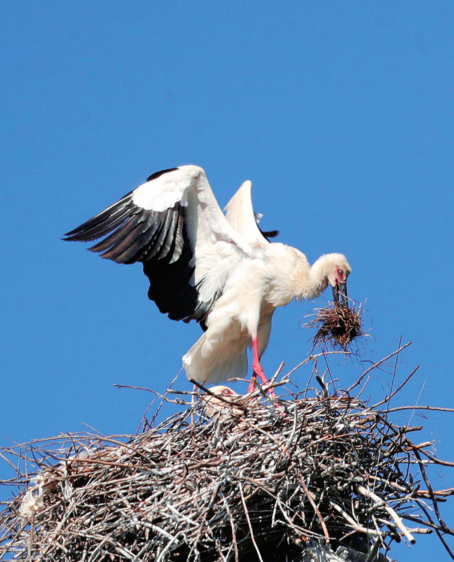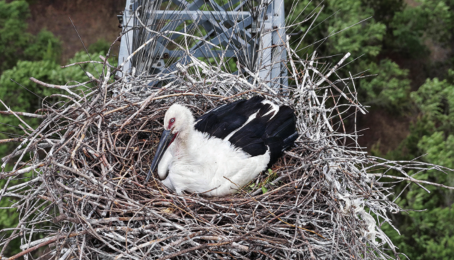Oriental white storks found nesting, breeding in Shanxi
First time for birds to be seen so far south in summer

Oriental white storks were observed nesting and breeding for the first time in North China's Shanxi province recently, a clear testament to the increasing numbers of this rare species and the success of local environmental protection efforts.
The Oriental white stork is a first-class animal under State protection. With limited breeding grounds and a global estimated population between 7,000 and 9,000, it has been classified as endangered by the International Union for Conservation of Nature.
On May 9, Chai Run, a 61-year-old wildlife photography enthusiast and conservation volunteer from Yunzhou district in Datong city, was photographing on the northern bank of the Sanggan River when he found that two Oriental white storks had built a nest atop a high-voltage transmission tower.
The storks are wading birds typically found in shallow water areas along lake edges, primarily feeding on fish and shrimp. Chai said that while Oriental white storks typically prefer nesting on cliffs, the increasing trend of them nesting on power towers across the country might be due to a perceived sense of safety.
The Sanggan River National Wetland Park in Datong is a crucial stopover site on the migratory route of many birds. With improvements in the environment, the park is home to over 100 bird species, including seven first-class protected birds such as the black stork and the Oriental white stork.
Oriental white storks migrate, with their breeding grounds mainly in Russia's Far East and northeastern China, and their wintering grounds in places like the Yellow River Delta in China. They arrive in southern China each October and migrate northward again by March.
Since the 1960s, the Oriental stork population had sharply declined due to excessive exploitation of natural resources and overhunting by humans. However, through dedicated efforts in habitat protection and artificial nest platform construction, their numbers have gradually recovered.
Guo Zhong, a 63-year-old wildlife protection volunteer in Datong, was quick to arrive at the scene upon hearing of the finding. With his extensive bird-watching experience, he recognized the significance of the white storks nesting and immediately began monitoring them.
Guo, also an avid bird photographer, mentioned that while he had often observed Oriental white storks during the spring and autumn migration seasons, with up to eight sightings in a year, this was the first time he had seen them nesting and breeding in the area.
"To avoid disturbing them, I consulted experts on the storks' ecological habits and used a telephoto lens from a safe distance of about 200 meters to record their activities, minimizing any close-range interference," Guo said. He observed that the two storks had a clear division of labor, taking turns incubating the eggs and foraging for food.
On the windy day they built their nest, some branches were blown away. The storks quickly fetched new materials, working together to repair and reinforce their home.
With 12 years of experience in wildlife protection advocacy and rescue, Guo's greatest wish is for Datong to establish a wildlife rescue station.
The discovery of the Oriental white storks nesting was made during routine patrols by volunteers such as Chai. Upon receiving the monitoring report, bird experts confirmed the species.
They speculated that the recent sightings of small groups of Oriental white storks were due to their increasing population and changes in traditional habitats.
Professor Guo Donglong from Shanxi University's School of Life Sciences told the Datong Daily that the discovery of new breeding sites for birds is usually influenced by multiple factors, including climate change, improvements in ecological environment and local efforts in bird protection.
Guo, who has been studying birds for over 40 years, confirmed that the Oriental white stork was previously considered a migratory bird in Shanxi, with only a few individuals occasionally wintering there.
Chai Run had already observed one chick in the nest. "With the Oriental stork population steadily recovering, this family may choose to stay here in the future. I will keep watching them," he said.

































